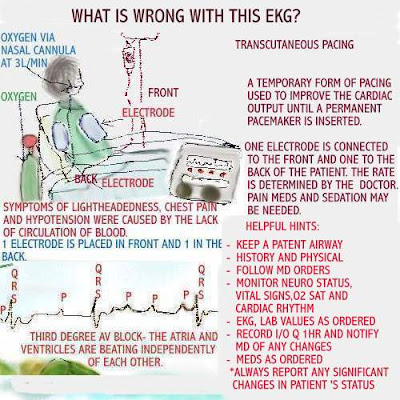FOR MORE HELPFUL INFORMATION ON THIS TOPIC, CLICK ON
THE LINK:
EKG SERIES -WHAT IS WRONG WITH THIS EKG.

TYPE 2 ( MOBITZ 2). TYPE 1 may be the result of
a myocardial infarction ( heart attack)involving the inferior wall of the heart. Depending on the degree of damage, it may be transient and only require observation.
TCP ( Transcutaneous Pacing )may be ordered by the doctor. It is often used as a bridge until a permanent pacemaker is inserted. Patients may need
analgesia and sedation during this period. The doctor will order whatever is necessary to keep the patient comfortable.
Assessment and documentation of the
neurological , respiratory and cardiac status is essential.
You may also enjoy watching the Clinical Videos called
SESSIONS, in particular
watch Sessions 16 through 18



 An overview of Ventricular Tachycardia is shown above. Clinical skills to attempt resuscitation of a patient with V-Tach calls for special training as ACLS. Please refer to American Heart's Guidelines for more information. Hope the above information is of some help to you. For the complete EKG series, just click on the link:http://www.dearnurses.com/ and enjoy reading: EKG SERIES- WHAT IS WRONG WITH THIS EKG.
An overview of Ventricular Tachycardia is shown above. Clinical skills to attempt resuscitation of a patient with V-Tach calls for special training as ACLS. Please refer to American Heart's Guidelines for more information. Hope the above information is of some help to you. For the complete EKG series, just click on the link:http://www.dearnurses.com/ and enjoy reading: EKG SERIES- WHAT IS WRONG WITH THIS EKG.


 Updated 4/24
Updated 4/24 Symptoms of patients in Third-Degree AV Block will vary from one patient to the next. If the patient is symptomatic , drugs such as Atropine is ordered by the doctor to improve the heart rate. *IV Infusions such as Epinephrine or Dopamine(in the absence of hypovolemia) may be used to improve blood pressure. To learn more about this topic and EKG reading, simply click on the link: EKG SERIES-WHAT IS WRONG WITH THIS EKG and enjoy learning.
Symptoms of patients in Third-Degree AV Block will vary from one patient to the next. If the patient is symptomatic , drugs such as Atropine is ordered by the doctor to improve the heart rate. *IV Infusions such as Epinephrine or Dopamine(in the absence of hypovolemia) may be used to improve blood pressure. To learn more about this topic and EKG reading, simply click on the link: EKG SERIES-WHAT IS WRONG WITH THIS EKG and enjoy learning.



 For more helpful information on EKG interpretation and cardiac issues, just click on the link:
For more helpful information on EKG interpretation and cardiac issues, just click on the link: This is an example of how a cardiac event can occur. History and physical is a very important part of the assessment when a patient is admitted. Character and the duration of the chest pain should also be documented.
This is an example of how a cardiac event can occur. History and physical is a very important part of the assessment when a patient is admitted. Character and the duration of the chest pain should also be documented.
